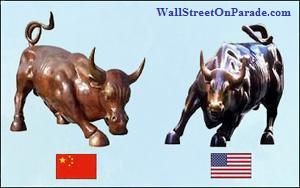By Pam Martens and Russ Martens: July 27, 2015
Despite unprecedented efforts by the Chinese government to stem the rout in the Chinese stock market that had shaved as much as $4 trillion from share prices before the government’s interventions this month and last, the Shanghai Composite closed down 8.48 percent today at 3,725.558.
The overnight rout has raised speculation in some quarters as to whether we are going to see another “glitch” on the New York Stock Exchange today similar to that of July 8 in the midst of another Chinese stock market tumble. As we reported at the time:
“Yesterday, beginning at 11:32 a.m. and for the next three hours and forty minutes, the iconic New York Stock Exchange shuttered trading in all of its listed securities. The Exchange said it had experienced an internal glitch.
“Unknown to most Americans, some of those shuttered stocks on the New York Stock Exchange were Chinese stocks and among the largest capitalized companies in the world. More than 100 Chinese companies trade on U.S. stock exchanges as American Depository Receipts (ADRs) and almost 200 Chinese company ADRs trade over-the-counter in the U.S. (Individual shares are referred to as ADS, American Depository Shares.) Last year, Thomson Reuters estimated the market value of Chinese companies listed on just the New York Stock Exchange and Nasdaq Stock Market at more than $1.4 trillion.
“With the Chinese stock market rupturing over the past week and trading in more than a thousand stocks suspended in China, the spillover has hit the U.S. market hard.
“According to PricewaterhouseCoopers’ March 31, 2015 list of the largest 100 global companies by market cap, there are 11 Chinese companies in that group. We took a look at trading in just two of those names yesterday, China Mobile and China Life Insurance, both of which trade as ADRs on the New York Stock Exchange.
“We looked at how China Mobile and China Life Insurance traded before, during and after the New York Stock Exchange halted trading in all of its securities. An interesting pattern emerged…After volume spikes in the morning prior to the trading halt by the Exchange, volume was subdued during the hours the Exchange remained closed. (Other trading venues are supposed to pick up the slack when an exchange goes dark.) Then volume picked up again when the Exchange reopened. China Mobile (symbol CHL) closed down 5.38 percent yesterday while China Life Insurance (symbol LTR) dropped 6.65 percent in New York trading.”
The worry on Wall Street is whether traders in New York will be willing to provide a two-sided market in Chinese shares at a time when the stock market situation there, as well as the economic situation, is deeply clouded.
Reuters reported that 2,247 Chinese stocks fell overnight while a meager 77 shares gained in price. The wire service also reported: “More than 1,500 shares listed in Shanghai and Shenzhen dived by their 10 percent daily limit.” When a stock market halts trading because a stock is limit-down 10 percent, that aborted selling pressure in China can seek relief in the next stock market to open where Chinese stocks are traded – like the New York Stock Exchange.
The wildly inflated price to earnings ratio of many Chinese stocks is drawing parallels in some investor minds to Japan’s Nikkei 225 index in 1989 when there were predictions that it would zoom to 45,000. On December 29, 1989, the Nikkei closed at 38,916. By 1991 it was below 25,000. By 1992 it was under 17,000. During the global crash in 2009 it traded in the 7000s before bottoming out. Today, the Nikkei finished at 20,350.10 – still down 48 percent after 25 years. After the 1929 crash, it took the U.S. market exactly 25 years to regain its peak.
As we’ve been writing this article, the Dow Jones futures have moved from a loss of -91 to a loss of -111 to a loss of -125. Trading in New York will be worth watching this week.


